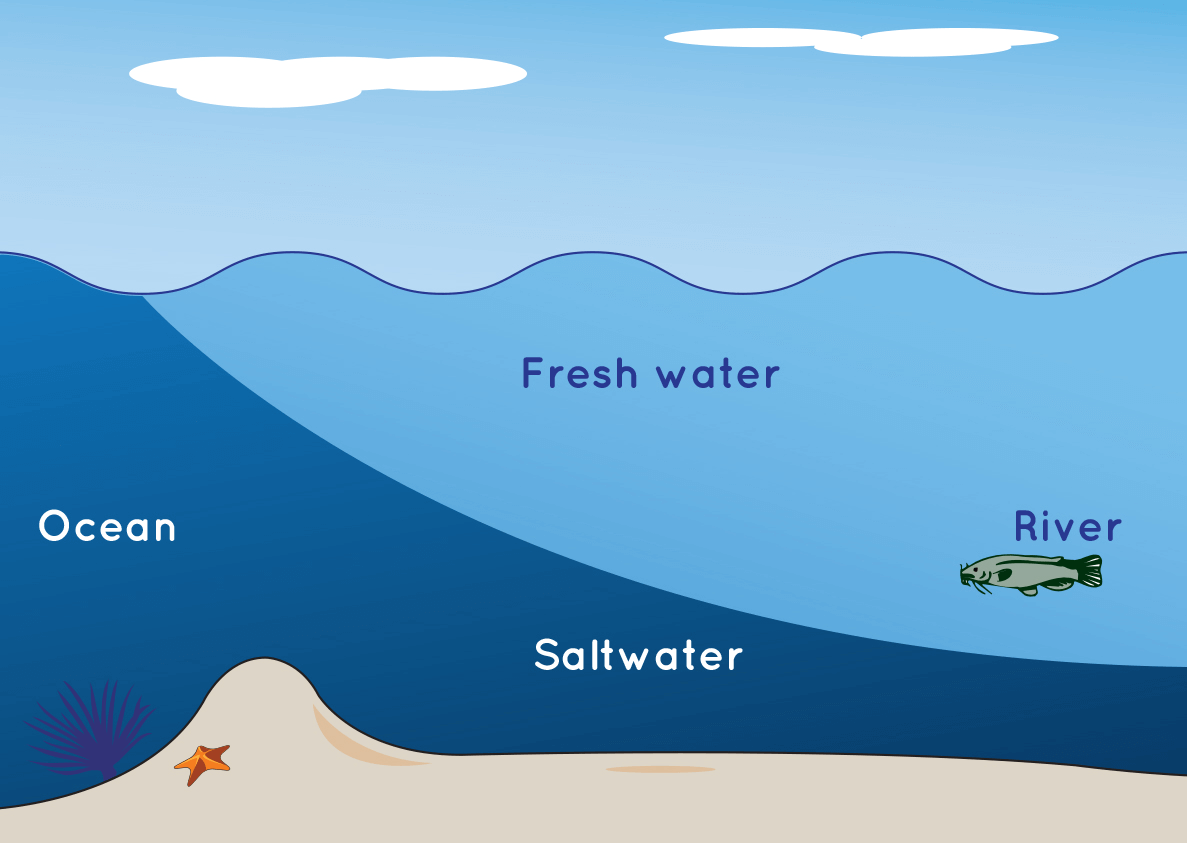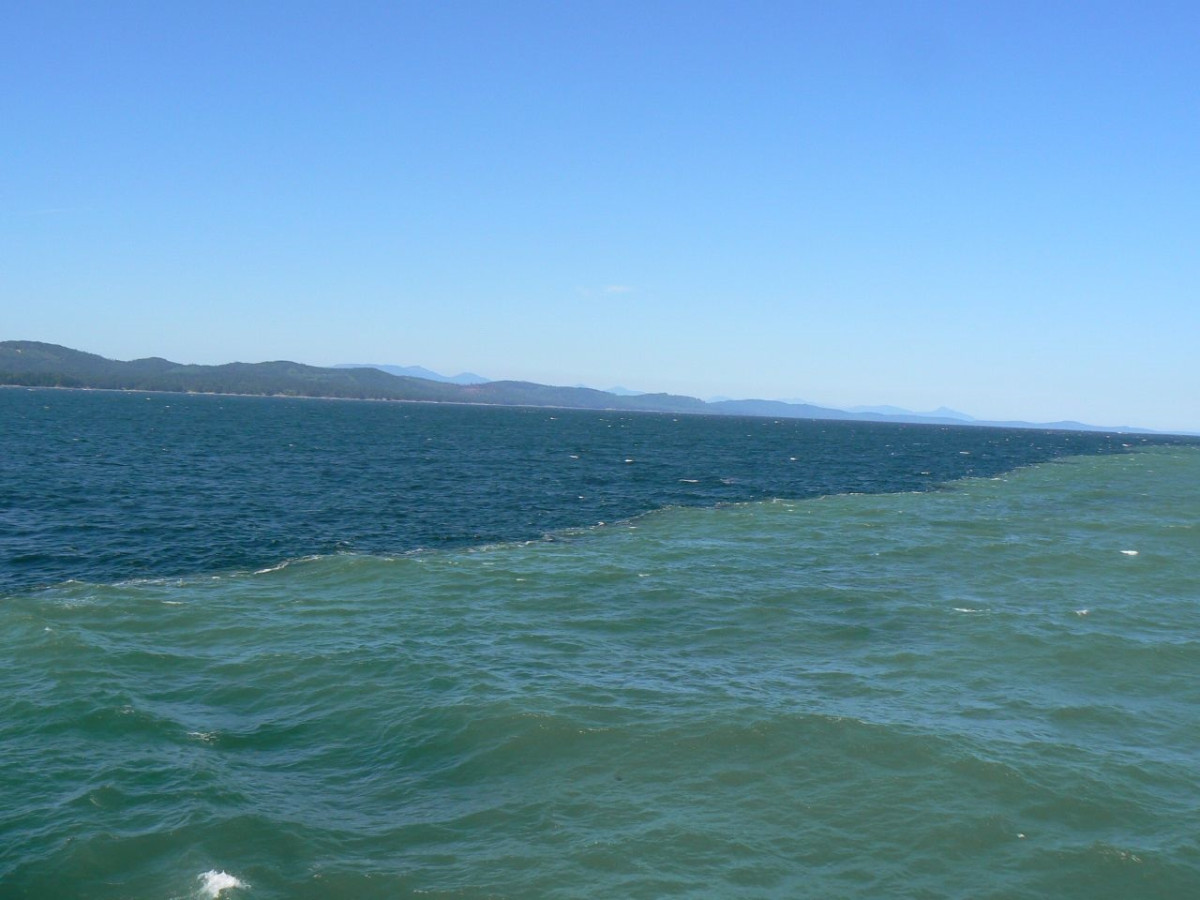One of the most well-known qualities of the ocean is that it is salty. The two most common elements in seawater, after oxygen and hydrogen, are sodium and chloride. Sodium and chloride combine to form what we know as table salt. Does Freshwater and Saltwater Mix: Mixing of Rivers with Seawater?
Freshwater and saltwater mix, but the process is slow and gradually influenced by factors like density & temperature. The mixing of freshwater & saltwater occurs naturally in estuaries, forming brackish water. Brackish water salinity content can vary from 0.5 to 35 parts per thousand (ppt).
Saltwater intrusion typically occurs in coastal regions and estuaries, where the freshwater becomes brackish as it mingles with the saltier seawater this happens every day throughout the earth.
Introduction:
Have you ever wondered if freshwater mixes with saltwater, or what happens when these two waters meet? It seems like something that happens all the time and it does, but the reality involves a complex dance of physical and chemical reactions. This article aims to explore the intriguing intricacies of the meeting of freshwater and saltwater, whether they be in vast oceans or tiny estuaries. Expect a thorough exploration of the phenomenon of water mixing and its implications ranging from salinity gradients to the sustenance of marine ecosystems.
Does Freshwater and Saltwater Mix
It’s a common misconception that freshwater and saltwater don’t mix. Yet, this couldn’t be further from the truth. The ability for freshwater and saltwater to combine is a critical aspect of our planet’s water cycle, and vital for maintaining healthy ecosystems. Here’s how it does mix. When freshwater enters a body of salt water, it initially floats on the top due to its lighter density. However, with time and the influence of gravity, the waters begin mixing, forming a partially mixed water type known as freshwater brackish.
One natural example of this mix is river water, being a primary source of fresh water, flowing into the sea. A meeting point where river water freshwater, laden with essential nutrients, meets salt-content-rich seawater. Over time, the freshwater-saltwater interaction gives way to a gradual mixing process, leading to water saltwater formation with varying degrees of salinity.
Yet, despite their ability to mix, freshwater and saltwater maintain unique compositions due to different dissolved salt concentrations. While the process of mixing is not immediate, it does happen, forming layers of varied salinity. Understanding this dynamic freshwater saltwater mix, how it occurs in nature, and how saltwater mixes with river and sea water is crucial for deciphering the influences that govern the Earth’s water systems.
So, yes, saltwater freshwater does blend together, complicating our earlier presumption of water segregation. The knowledge that salt, water, and mixing are essential parts of our natural world helps us grasp the complexities of our planet’s water system.
When freshwater and saltwater meet, they do mix to some extent, but the mixing is not complete due to differences in density and salinity. Freshwater is less dense than saltwater, so when they come into contact, a sharp boundary is created.
Freshwater tends to float on top of the denser saltwater, creating distinct layers. Some mixing does occur at the boundary between the two water masses, but it is generally slight. The mixing of seawater and freshwater in estuaries is called Brackish water, and its salinity can vary from 0.5 to 35 parts per thousand (ppt).
Does Freshwater Meet Saltwater: Unravelling the Science of Mixing Waters
Seawater salinity is expressed as a ratio of salt (in grams) to a liter of water, It is written parts per thousand (ppt). In seawater, there are typically close to 35 grams of dissolved salts in each liter ranging between 33-37 grams per liter or 3.5%. Not all Ocean water or seawater is the same.
The ocean has areas of high and low salinity. Of the five ocean basins, the Atlantic Ocean is the saltiest. On average, there is a distinct decrease in salinity near the equator and at both poles, although for different reasons.
Near the equator, the tropics receive the most rain on a consistent basis. As a result, the fresh rainwater falling into the ocean decreases the salinity of the surface water in that region. Rain decreases further from the equator, and with less rain and more sunshine, evaporation increases.
Evaporation of water vapor from the ocean to the atmosphere leaves behind the salt, resulting in higher salinity. Toward the poles, fresh water from melting ice decreases the surface salinity once again.
When freshwater meets salt water, a natural phenomenon occurs. The mixture of fresh and saltwater creates a density difference between the two layers of water. This combination of water, differing in salt content, forms what’s known as brackish water, an intermediary mix of fresh and salt water.
Typically, this interesting mix happens in estuaries, partly enclosed bodies of water where rivers meet salty ocean tides. But, does this mean freshwater and saltwater simply combine? They do, but not evenly. Freshwater, being less dense, generally stays on top of salt water, creating a fascinating layer called stratification.
It’s this very density difference that makes the mixing so unique. Yet, the layers aren’t permanently separate. Environmental factors, like wind and tide, encourage a gradual mixing of the waters, leading to a healthy exchange of nutrients crucial for marine ecosystems. In simpler terms, fresh water was mixed with salt water to create an eco-rich area.
So, does freshwater meet saltwater? Absolutely. The mixing of water, whether salty or fresh, is a beautiful showcase of nature’s seamless intermixing. And yes, if you’re wondering, freshwater and saltwater do mix and they certainly put on quite a show while on it.

Understanding Fresh Water and Saltwater Intrusion
When it comes to understanding fresh water and saltwater intrusion, it might seem like a simple question: does fresh water mix with salt water? It’s true when freshwater meets saltwater, they do combine, but not in the way you might think. This meeting of the two, often referred to as ‘salt intrusion’, is an intriguing scientific phenomenon that paints a picture of the delicate balance between these two water bodies. This is why.
Saltwater intrusion typically occurs in coastal regions and estuaries, where the freshwater becomes brackish as it mingles with the saltier seawater. It’s not an immediate and total blend. Instead, it’s a gradual process, a dance if you will, between the waters to keep the perfect mix. The process leverages a gradient of salinity, ascending from the freshwater to the heavily salted sea. The end result is a unique combination that’s neither purely freshwater nor saltwater, but something in between.
However, the story does end there. The science behind the mixing of fresh water and salt water is complex and fascinating. It’s more than just a quick meet and dash. The waters interact with each other, an event known as ‘saltwater intrusion’.
It’s a natural occurrence where density, temperature, and stirring forces play significant parts. The complexity of this scientific interaction, and thus the understanding of it, underscores the importance of water stewardship and conservation.
Exploring the Article: Does Fresh Water Mix with Saltwater
In this article, we’re about to dive into the viral chemistry of water that’ll make understanding the mixing of fresh water and salt water as clear as a coastal estuary. So, do fresh water and salt water mix? Yes, it does mix.
Estuaries are the areas where freshwater rivers or streams meet the ocean, creating this unique mix of water with a slightly salty character. The term “brackish” describes water that is somewhat saline but not as salty as seawater. The mixing of freshwater and saltwater in estuaries is essential for various ecosystems and serves as a transitional zone between the two types of water.
When salty water mixes with fresh water, there’s a complex chemistry at work, intricately tied to Earth’s countless water sources. Water, be it freshwater or seawater, plays a significant role in this global chemistry. Yet, when you see how freshwater saltwater mixes in nature, like in an estuary, it’s astounding but happens every day.
The mixing of salty water and freshwater is a topic that has caught much intrigue in recent times becoming somewhat viral, especially among science buffs and nature lovers. Now, thanks to easy access to learning resources online, the mystery is slowly decaying, and understanding is flowing as steadily as a river.
Conclusion:
In conclusion, while it’s a fascinating natural phenomenon, the mixing process of saltwater and freshwater isn’t as straightforward as it might seem. Multiple factors such as temperature, density, and salinity play significant roles and it is not an immediate blend. It’s a striking testament to the complexity of our natural world. The next time you see a river flowing into the sea, take a moment to marvel at the extraordinary dance of nature taking place right in front of your eyes.

References:
NOAA- Seawater and Freshwater
Brittanica-Composition of Seawater
FAQ’s
Q: Do freshwater and saltwater mix?
A: Yes, freshwater and saltwater do mix. When freshwater meets saltwater, there’s a complex chemistry at work. Freshwater initially floats on the top due to its lighter density but with time, the waters begin mixing.
Q: Where does the freshwater and saltwater mixture happen naturally?
A: This phenomenon typically happens in places like estuaries, which are partly enclosed water bodies where rivers meet the sea.
Q: What is formed when freshwater and saltwater mix?
A: The mixing of freshwater and saltwater forms what’s known as brackish water which varies in levels of salinity, being neither purely freshwater nor saltwater.
Q: Why is understanding the freshwater and saltwater mixture crucial?
A: Understanding how freshwater and saltwater mix is crucial for understanding the complexities of our planet’s water system and the role it plays in maintaining the health of marine ecosystems.


